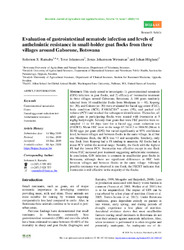| dc.contributor.author | Ramabu, Solomon S. | |
| dc.contributor.author | Johansson, Tove | |
| dc.contributor.author | Wensman, Jonas Johansson | |
| dc.contributor.author | Höglund, Johan | |
| dc.date.accessioned | 2022-06-02T08:22:13Z | |
| dc.date.available | 2022-06-02T08:22:13Z | |
| dc.date.issued | 2020-04-04 | |
| dc.identifier.citation | Ramabu, S. S., Johansson, T., Wensman, J. J., & Höglund, J. (2020). Evaluation of gastrointestinal nematode infection and levels of anthelmintic resistance in small-holder goat flocks from three villages around Gaborone, Botswana. Botswana Journal of Agriculture and Applied Sciences, 14(1), 1-6. | en_US |
| dc.identifier.issn | 1815-5574 | |
| dc.identifier.uri | https://bojaas.buan.ac.bw/index.php/jaas/article/view/23 | |
| dc.identifier.uri | https://hdl.handle.net/13049/475 | |
| dc.description | Article, BOJAAS, 2020 | en_US |
| dc.description.abstract | Abstract: This study aimed to investigate: 1) gastrointestinal nematode (GIN) infection in goat flocks, and 2) efficacy of ivermectin treatment in three villages around Gaborone, Botswana. A 100 goats randomly selected from 10 smallholder flocks from Modipane (n = 40), Kopong (n= 30), and Gakuto (n= 30) were evaluated for faecal egg count (FEC), body condition (BCS), FAMACHA® scores (FS), and packed cell volume (PCV) and marked for subsequent identification. Thereafter, all adult goats in participating flocks were treated with ivermectin at 5 mg/kg bodyweight. Seventy-four goats that were FEC positive were resampled 11 to 14 days later for a faecal egg count reduction test (FECRT). Mean FEC were in the range 67.5±14.2 to 380±50 (Mean ± SEM) eggs per gram (EPG) but varied significantly at 95% confidence level, between villages and between flocks in the same village. In all but one Modipane flock, the BCS was >3 and acceptable. Similarly, only one flock from Kopong had a FS tending to anaemia. All flocks had a mean PCV within the normal range. Notably, the flock with the highest FS had the lowest PCV. Ivermectin was effective except in one flock whose FEC increased post treatment suggesting anthelmintic resistance. In conclusion, GIN infection is common in smallholder goat flocks in Botswana, although there are significant differences in FEC both between villages and between flocks in the same village. Although possible resistance was observed in one flock, the FECRT indicates that ivermectin is still effective in the majority of the flocks. | en_US |
| dc.language.iso | en | en_US |
| dc.publisher | Botswana University of Agriculture & Natural Resources | en_US |
| dc.relation.ispartofseries | Botswana Journal of Agriculture and Applied Sciences;Volume 14, Issue 1 (2020) 1–6 | |
| dc.subject | Gastrointestinal nematodes | en_US |
| dc.subject | Goats | en_US |
| dc.subject | Faecal egg count reduction test | en_US |
| dc.subject | Anthelmintic resistance | en_US |
| dc.subject | Ivermectin | en_US |
| dc.title | Evaluation of gastrointestinal nematode infection and levels of anthelmintic resistance in small-holder goat flocks from three villages around Gaborone, Botswana | en_US |
| dc.type | Article | en_US |

